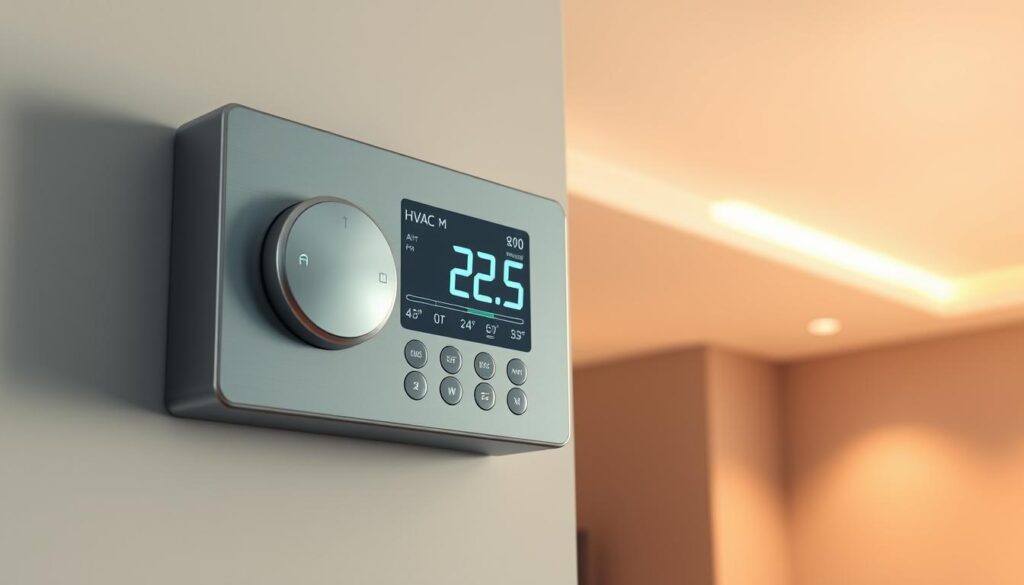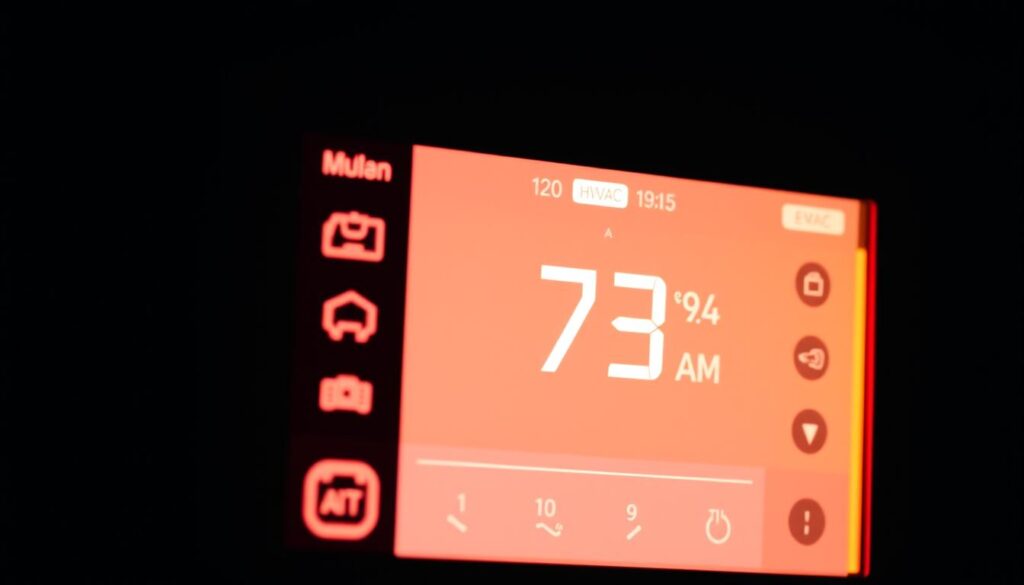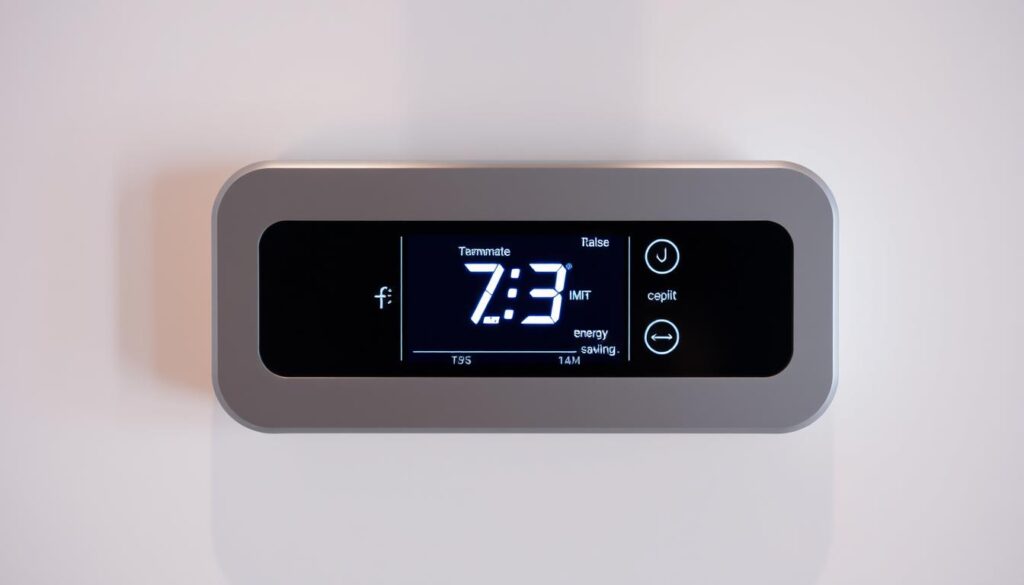Affiliate Disclosure
HVAC Guide Guys is a participant in the Amazon Services LLC Associates Program, an affiliate advertising program designed to provide a means for sites to earn advertising fees by advertising and linking to Amazon.
How HVAC Thermostats Work? Ever wondered how your home stays just the right temperature with a simple touch? It’s all thanks to the HVAC thermostat control system. This system works quietly in the background to keep you cozy.

In the U.S., about 87% of homes have air conditioning. Knowing how your thermostat works can change how you enjoy your home. It’s not just a dial; it’s the heart of your heating and cooling system.
This guide will explain how HVAC thermostats work. It will help you control your home’s temperature and save money on energy bills.
Key Takeaways
- Understand the fundamental role of thermostats in home temperature management
- Learn how HVAC thermostat control systems optimize home comfort
- Discover how smart thermostats can save you money
- Explore the technology behind keeping your home at the right temperature
- Gain insights into efficient home climate control
Table of Contents
Understanding HVAC Thermostat Basics
HVAC thermostats are key devices for managing your home’s temperature. They help keep your home comfortable and save energy. These systems are smart and easy to use.
Types of HVAC Thermostats
There are many types of HVAC thermostats:
- Mechanical Thermostats: Traditional systems using bimetallic strips
- Digital Thermostats: Advanced electronic temperature controllers
- Programmable Thermostats: Flexible scheduling options
- Smart Thermostats: Wi-Fi enabled with advanced features
Core Functions and Features
Modern thermostats have amazing features for controlling temperature. About 75% of homeowners use programmable digital thermostats. This helps save energy and make homes more comfortable.
| Thermostat Mode | Primary Function |
|---|---|
| Auto Mode | Automatically regulate heating and cooling |
| Heat/Cool Mode | Manage temperature transitions |
| Eco Mode | Implement energy-efficient settings |
Basic Components of a Thermostat
Knowing your thermostat’s parts is important. The main parts are:
- Temperature Sensor
- Control Board
- Display Panel
- Electrical Connections
“A thermostat is more than just a device—it’s your home’s climate management system.”
Digital thermostats have cool features like Wi-Fi and smartphone control. They change how we manage our home’s temperature.
Explore Our HVAC Shop
Looking for top-rated HVAC tools, parts, and accessories? Visit our shop and find the perfect solution for your needs.
Visit the ShopHow HVAC Thermostat Works in Your Home
Knowing how an HVAC thermostat controls your home’s climate is key. It keeps your home comfortable and saves energy. The thermostat is like a brain for your heating and cooling system, always watching and adjusting the temperature.
When you choose a temperature, the thermostat starts its work. Here’s what it does:
- Temperature Sensing: It checks the room’s temperature with sensors.
- Comparative Analysis: It compares this temperature to what you want.
- System Activation: It tells the HVAC to start heating or cooling.
“Your thermostat is like a vigilant guardian, ensuring your home’s comfort with precision and efficiency.”
When it’s time to heat, the thermostat tells the furnace to start. The furnace’s metal exchanger gets hot. Then, the furnace fan blows warm air through your home’s ducts.
| Temperature Setting | Energy Impact |
|---|---|
| 26°C (Recommended Comfort) | Optimal cooling cost reduction |
| 19°C | Extended AC runtime |
| 31°C (Vacation Setting) | Prevents overheating, minimizes energy costs |
Pro Tip: Most U.S. homes use central heating and cooling systems. Knowing how they work can save you 10-15% on energy bills.
The cooling process is similar. When it gets too hot, the thermostat tells the air conditioner to cool things down. This keeps your home comfy and saves energy.
The Evolution of Temperature Control Systems
Temperature control has evolved a lot over time. It started with simple devices and now we have smart thermostats. This shows how much technology has improved in managing home climates.
The first mercury thermostat was invented in 1620 by Cornelis Drebbel. Then, Andrew Ure made the bi-metallic thermostat in 1830. Warren Johnson introduced the multi-zone control system in 1885.
From Manual to Digital Controls
Early thermostats were simple and didn’t do much. People had to adjust them manually. Important changes included:
- 1906: Honeywell introduces the first commercial thermostat, the “Jewell”
- 1950s: Dial thermostats become widely available
- 1980s: Programmable electronic thermostats emerge
Modern Smart Thermostat Technologies
Smart thermostats are a big step forward in controlling home temperatures. They offer features that change how we manage our homes’ temperatures.
| Feature | Benefit |
|---|---|
| WiFi Connectivity | Remote temperature control |
| Machine Learning | Automatic schedule optimization |
| Energy Tracking | Detailed consumption insights |
Integration with Home Automation
Smart thermostats now work with home automation systems. You can control your home’s temperature with apps, voice assistants, and smart home platforms.
“The future of home comfort is intelligent, connected, and personalized.” – HVAC Technology Insights
By 2023, the global HVAC control market is expected to hit $27 billion. This shows how important smart thermostats are in home automation today.
Explore Our HVAC Shop
Looking for top-rated HVAC tools, parts, and accessories? Visit our shop and find the perfect solution for your needs.
Visit the ShopReading and Interpreting Your Thermostat Display

Understanding your thermostat display is key for controlling your home’s temperature. Modern thermostats show a lot of info at once. This makes it easy to manage your home’s climate.
The display shows two main temperature readings:
- Top Number: The temperature you’ve set
- Bottom Number: The current room temperature
Your thermostat control system has indicators for important climate info:
- Mode Indicators:
- Heat: When the heating system is on
- Cool: When the cooling system is on
- Auto: When it switches between heat and cool
- Fan Settings:
- “O” means air is being distributed passively
- Independent fan operation for air circulation
“A well-understood thermostat is the key to home comfort and energy efficiency.” – HVAC Expert
Digital thermostats are easy to use. You just need to press up and down buttons to change settings. They let you set different temperatures for different times and days. This saves energy and keeps you comfortable.
Pro tip: Lowering your thermostat by two degrees can cut down on heating and cooling costs. It also helps save energy.
Temperature Regulation and Control Mechanisms
Your HVAC system keeps your home comfortable thanks to advanced temperature control. Knowing how it works can make your heating and cooling more efficient.
Modern temperature control uses sensors, control systems, and your home’s heat. The U.S. Department of Energy says this can cut down on energy use a lot.
Heat Sensing Technologies
Thermostats use special heat sensing tech to get your home’s temperature right. They include:
- Thermistors: Electrical resistors that change resistance with temperature
- Infrared sensors: Catch heat from surfaces around them
- Digital temperature probes: Give exact electronic temperature readings
Cooling System Integration
Good HVAC system optimization means cool systems work together well. Smart thermostats can handle different cooling zones, keeping your home evenly cool.
| Zoning System | Energy Savings | Ductwork Capacity |
|---|---|---|
| Two-Zone System | Up to 30% | 70% Total CFM |
| Three-Zone System | Up to 35% | 50% Total CFM |
| Four-Zone System | Up to 40% | Needs More Duct Size |
Temperature Differential Settings
Temperature differential settings control how often your HVAC system turns on. Setting it right can save energy and wear on the system. Choosing the right temperature differences can cut your heating and cooling costs by up to 15%.
“Effective temperature regulation is not just about comfort, but about smart energy management.” – HVAC Efficiency Expert
Learning about these temperature control methods can change your home’s comfort and energy use. Using these smart technologies can save you money and help the environment.
Programming Your HVAC Thermostat for Optimal Performance

Learning to use programmable thermostats can save a lot of energy at home. You could cut your energy bills by 10% to 30% every year. The secret is to know how to manage your HVAC system’s temperature wisely.
Here are some top tips for setting up your thermostat:
- Set different temperatures for wake, sleep, and away periods
- Create unique schedules for weekdays and weekends
- Utilize seasonal adjustment settings
- Leverage smart thermostat learning algorithms
The Department of Energy suggests lowering your thermostat by 7-10 degrees when you’re not home. In winter, keep it at 68°F when you’re home and awake. In summer, aim for 78°F for the best energy use.
“Small adjustments to your thermostat can result in significant energy savings over time.” – Energy Efficiency Experts
Today’s programmable thermostats have many scheduling options:
- 7-Day Programming: Customize settings for each day
- 5-1-1 Programming: Different schedules for weekdays, Saturday, and Sunday
- 5-2 Programming: Consistent weekday and weekend settings
Smart thermostat technologies take HVAC system optimization to the next level. With geofencing and automatic learning, these devices can adjust temperatures based on your habits. This can save you an extra 15% on energy costs.
Explore Our HVAC Shop
Looking for top-rated HVAC tools, parts, and accessories? Visit our shop and find the perfect solution for your needs.
Visit the ShopEnergy Efficiency and Cost Savings
Your HVAC system uses a lot of energy in your home. Learning how to make it work better can save you money and help the planet.
Peak Usage Management
Many homes with programmable thermostats don’t use them right. By managing energy use wisely, you can cut down on waste and bills.
- Find out when you use the most energy
- Change your thermostat settings during busy times
- Use geofencing to adjust your thermostat automatically
Schedule Optimization Tips
Smart thermostats are great for making your HVAC system better. The U.S. Department of Energy says you can save 10% a year by adjusting your temperature a bit.
- Make temperature plans based on who’s home
- Use smart settings to lower the temperature when you’re not there
- Connect it to your smart home
Energy Conservation Strategies
“Smart thermostats are not just devices, they’re your personal energy management assistants.”
There are many ways to make your HVAC system more efficient:
- Use zoned heating and cooling
- Let nature help control your temperature
- Check your energy use reports
- Join utility programs to save more
Using these tips can help you save money and be kinder to the environment.
Troubleshooting Common Thermostat Issues
Knowing how your thermostat works can help fix common problems fast. About 25% of thermostat issues are due to dead batteries. These are easy to fix without needing to be a tech expert.
“A well-maintained thermostat is key to efficient hvac thermostat functioning”
Now, let’s look at the most common thermostat problems:
- Battery-related problems (25% of failures)
- Replace batteries regularly
- Check battery contacts for corrosion
- Wiring issues (30% of operational problems)
- Inspect loose connections
- Ensure proper wire alignment
- Sensor malfunctions (35% of temperature regulation errors)
- Clean sensors carefully
- Avoid placing near heat sources
Putting your thermostat in the wrong spot can make heating and cooling less accurate by up to 15%. Experts say to install it about 5 feet off the floor. It should be away from sunlight, drafts, and heat sources.
Pro Tip: Regular maintenance can improve thermostat performance by 20%!
When you’re trying to fix it, always check these key areas:
- Power supply and batteries
- Circuit breaker status
- Wiring connections
- Sensor cleanliness
- Configuration settings
If you can’t fix it after trying these steps, get help from a pro HVAC technician. Thermostats over 10 years old might need to be replaced. This ensures your home stays comfortable.
Explore Our HVAC Shop
Looking for top-rated HVAC tools, parts, and accessories? Visit our shop and find the perfect solution for your needs.
Visit the ShopSmart Thermostat Features and Benefits
Smart thermostats have changed how we control our homes. They do more than just set the temperature. They help save energy and make our homes more comfortable.
The main benefits of smart thermostats are:
- Remote control via smartphone apps
- Learning algorithms that adapt to your lifestyle
- Detailed energy usage reporting
- Integration with voice assistants
- Automatic temperature adjustments
Smart thermostats learn your preferences. They use advanced sensors and geofencing technology to adjust the temperature for you. They can cool your home when you’re away and warm it up when you return.
Smart thermostats can save about 8% on heating and cooling costs each year. This means big savings on energy bills.
Smart thermostats also integrate well with home automation. They work with virtual assistants like Amazon Alexa and Google Home. This lets you control your home’s temperature with just your voice.
| Feature | Benefit |
|---|---|
| Geofencing | Automatic temperature adjustment based on smartphone location |
| Energy Reports | Detailed insights into consumption patterns |
| Voice Control | Hands-free temperature management |
| Learning Algorithms | Personalized temperature optimization |
Smart thermostats have great benefits, but they also have some downsides. They cost between $80 and $300, and installation can add $50 to $150. Some models need a professional to install them, which can be more expensive.
Getting a smart thermostat is more than just a convenience. It’s about making your home more energy-efficient and comfortable. It’s about using smart technology to improve your living space.
Conclusion
Learning about HVAC thermostats changes how you handle your home’s energy use. These smart devices do more than just control the temperature. They help make your home comfortable while saving energy.
Modern thermostats give you control over your home’s climate like never before. Smart thermostats can learn your preferences and adjust settings for you. This can cut your heating and cooling costs by 10-15%.
With smartphone apps, you can control your home’s temperature from anywhere. This makes managing your energy use easy and convenient.
Your journey to better indoor climate control is ongoing. As technology gets better, thermostats will too. They’ll offer even more precision and save more energy.
Staying up-to-date with thermostat technology is smart. It helps you make better choices for your HVAC system. This ensures your home stays comfortable, sustainable, and cost-effective for years.
Spending time to understand and improve your thermostat is worth it. It’s an investment in your home’s comfort and your wallet. Regular upkeep, smart programming, and new tech will make your home more efficient and responsive.

